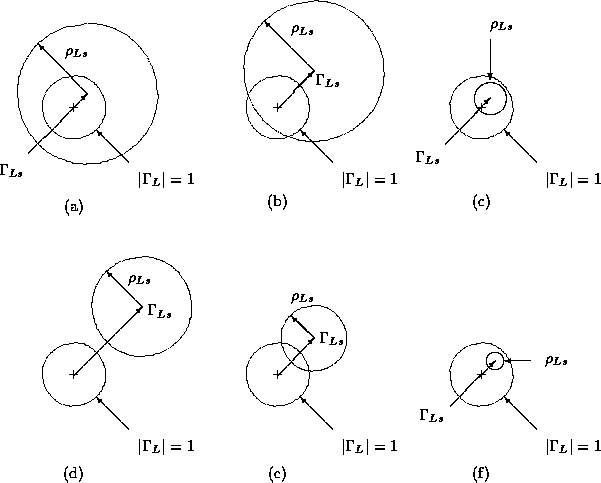We take the input stability circle on ![]() plane as the example. There
are six possible ways for the stability circle drawn on the
plane as the example. There
are six possible ways for the stability circle drawn on the ![]() plane as the
shown in Figure 17.
plane as the
shown in Figure 17.

Figure 17: Six possible ways for the input stability circle
We consider only the case where ![]() and
and ![]() . The
. The ![]() circle represents the
location where
circle represents the
location where ![]() on the
on the ![]() plane. Note that at the origin of the
plane. Note that at the origin of the ![]() plane,
plane, ![]() , hence a stable region. Therefore, the area including the origin of
the
, hence a stable region. Therefore, the area including the origin of
the ![]() plane up to the
plane up to the ![]() circle is the stable region. We can find that
circle is the stable region. We can find that
![]() for all values of
for all values of ![]() in Figure 17 (a) and 17 (d).
in Figure 17 (a) and 17 (d).
We re-examine the value of ![]()

Case (i) ![]()
![]()
this corresponds to Figure 17 (d), (e), (f). But Figure 17 (d) is unconditionally
stable, where

Because ![]() , we can re-write the condition as
, we can re-write the condition as
![]()
Case (ii) ![]()
![]()
this corresponds to Figure 17 (a), (b), (c). But Figure 17 (a) is unconditionally
stable, where

Because ![]() , we can re-write the condition as
, we can re-write the condition as
![]()
Therefore, a necessary condition for unconditionally stability is
![]()
If we define
![]()
then K>1 is a necessary condition for unconditionally stability.
If we examine the Figure 17 (b), (c), (e), (f) again, we find that
Therefore, K > 1 is not the sufficient condition for stability. We must find a way to
distinguish Figure 17 (a) from Figure 17 (c). The difference between
two Figures is that ![]() in Figure 17 (a). Therefore
in Figure 17 (a). Therefore
![]()
Combine with the inequality
![]()
![]()
Because ![]() for Figure 17 (a), (c). Finally, the necessary and sufficient conditions for unconditionally stability for the input port are
for Figure 17 (a), (c). Finally, the necessary and sufficient conditions for unconditionally stability for the input port are
![]()
Therefore, the necessary and sufficient conditions for unconditionally stable two-port network are
Example In a 50 ![]() system, a transistor has the following S-parameter at 1.3 GHz.
Examine the stability of the transistor.
system, a transistor has the following S-parameter at 1.3 GHz.
Examine the stability of the transistor.
![]()
![]()
Solution
![]()
![]()
![]()
The transistor is unconditionally stable.